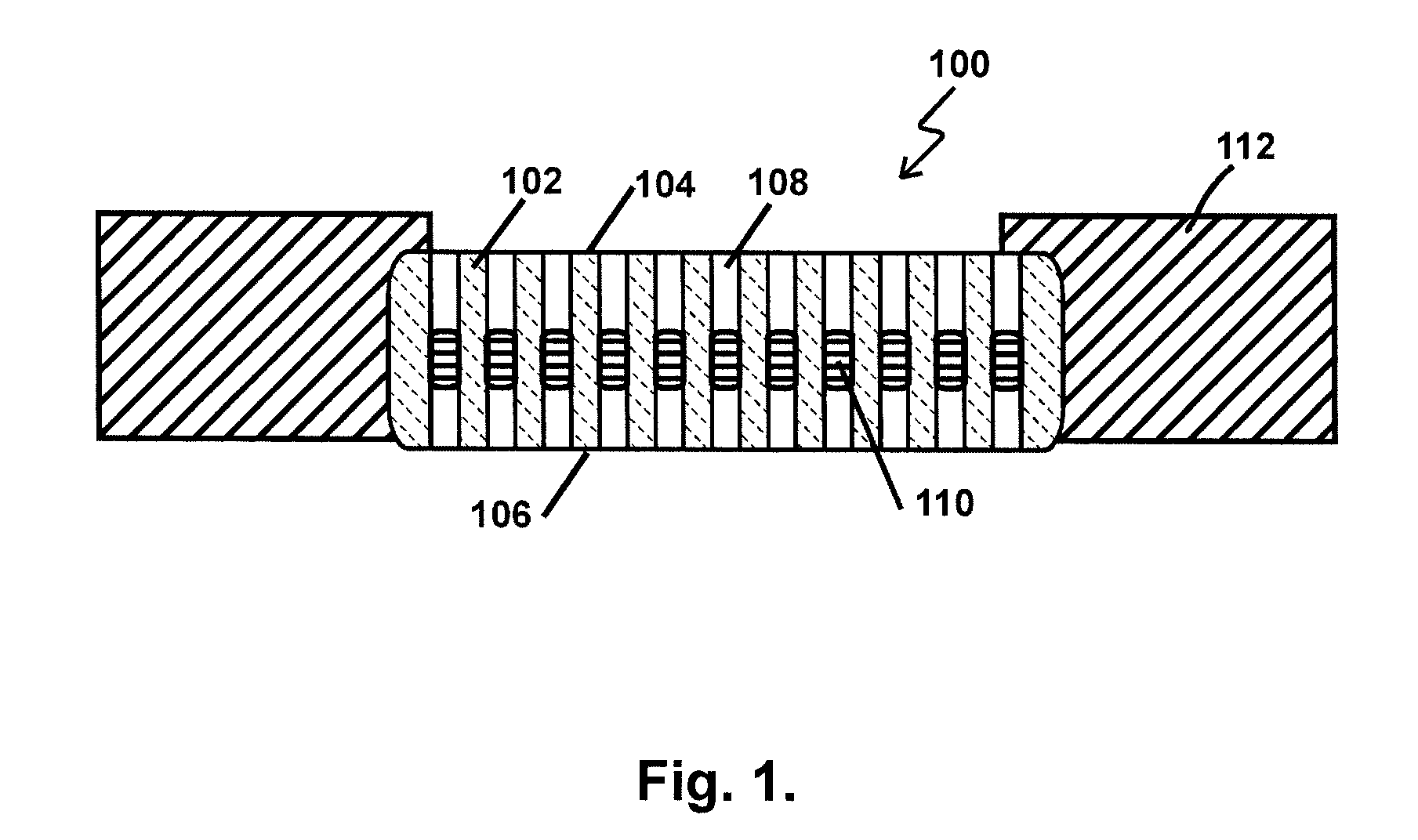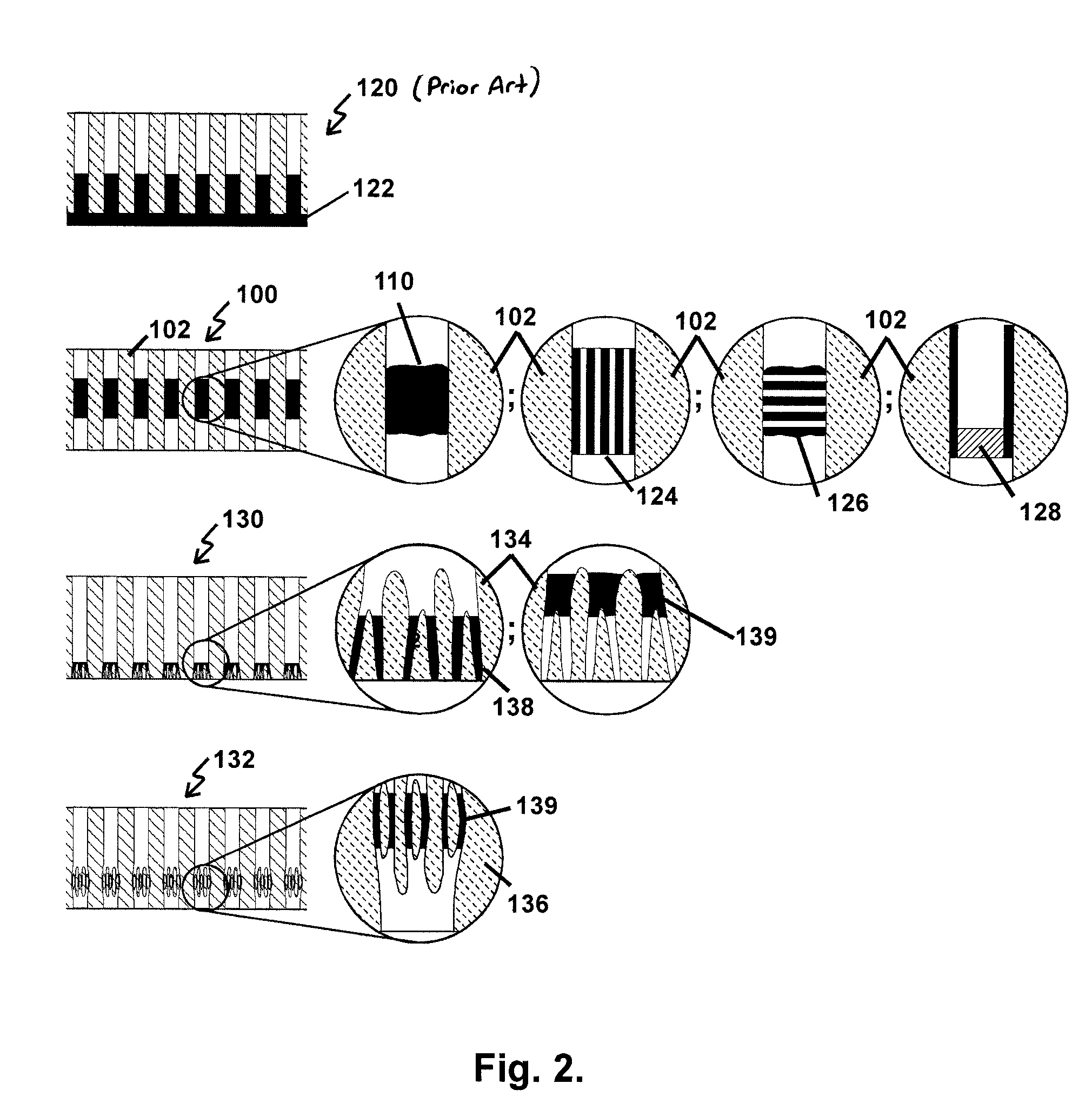Composite membranes and methods for making same
a technology of composite membranes and membranes, applied in the field of composite membranes, can solve the problems of poor mechanical integrity, poor flux, and high cost of supporting membranes, and achieve the effects of increasing the h2 flux, high permselectivity for h2, and increasing the resistance to thermal cycling and/or mechanical loads
- Summary
- Abstract
- Description
- Claims
- Application Information
AI Technical Summary
Benefits of technology
Problems solved by technology
Method used
Image
Examples
example 1
Blank Symmetric and Asymmetric Membranes
[0108] Blank AAO symmetric and asymmetric support membranes are formed by anodizing 99.99% pure Al foil that is rolled and pressure-annealed at 350° C. and 5,000 psi for 20 min. The resulting Al foil is cleaned and anodized on both sides in 1% oxalic acid electrolyte at a temperature of 10° C. and an anodization current density of 10 mA / cm2, until a charge density of 20 C / cm2 is accumulated. The resulting layer of aluminum oxide is then stripped in a hot solution of 200 g / l chromic oxide in 50% phosphoric acid, the Al substrate is rinsed and dried, and an adhesion layer of 0.5 μm of AAO is grown using the same conditions.
[0109] Conventional photoresist is applied to both sides of the Al substrate, is soft-baked at 90° C. for 20 min and is exposed to a UV light using a mask with the openings of required size and format to define the number, the location, the size and the format of the membranes—in this case, four 25 mm circular membranes on e...
example 2
Blank Symmetric and Asymmetric Membranes with an Al Rim
[0112] Blank AAO symmetric and asymmetric membranes are produced using Al foil prepared and patterned as noted in Example 1, except only one size of Al substrate is patterned with 13 mm membranes. Anodization is carried out in 3% oxalic acid electrolyte at a temperature of 12° C. and an anodization voltage of 40V until a charge density of 200 C / cm2 is accumulated, resulting in 100 μm thick AAO films with 37 nm pores. With some Al substrates, voltage reduction profile #2 (described above) is used to bring the anodization voltage down to 4 V, and anodization is continued for 100 seconds at 4V. The resulting asymmetric AAO has a final pore diameter of about 5 nm.
[0113] The resulting AAO supports, which are still attached to Al, are masked with 3M electroplating tape to define 8 mm circles in the center of the 13 mm membranes. The barrier layer in the exposed area was breached in a solution of concentrated hydrochloric acid at −2°...
example 3
Composite AAO / Pd Membranes with Al rim for H2 Separation
[0114] Blank AAO membranes on Al foil are produced as previously noted in Example 2, except the process is stopped before masking for breaching of the barrier layer. Electrodeposition of a Cu sacrificial layer is carried out in an aqueous solution of 0.5M CuSO4 for 1000 seconds in potentiostatic mode using a 100 Hz sinusoidal waveform with an amplitude of ±9V and a DC offset of −0.5V. Electrodeposition of the active layer of Pd nanoplugs is carried out in a commercial PallaSpeed electrolyte (Technic) for 500 seconds in potentiostatic mode using a 100 Hz SINE waveform with an amplitude of ±9V and a DC offset of −0.5V. A backside of the Al foil opposite to the AAO support is masked to define an 8 mm circle and exposed Al is etched using a solution of 20% hydrochloric acid and 15% CuCl2 in water, until the backside of AAO / Pd / Cu membrane is exposed. The barrier layer is etched for 20 to 30 minutes in a solution of 0.5M of phosphor...
PUM
| Property | Measurement | Unit |
|---|---|---|
| pore diameter | aaaaa | aaaaa |
| pore diameter | aaaaa | aaaaa |
| thickness | aaaaa | aaaaa |
Abstract
Description
Claims
Application Information
 Login to View More
Login to View More - R&D
- Intellectual Property
- Life Sciences
- Materials
- Tech Scout
- Unparalleled Data Quality
- Higher Quality Content
- 60% Fewer Hallucinations
Browse by: Latest US Patents, China's latest patents, Technical Efficacy Thesaurus, Application Domain, Technology Topic, Popular Technical Reports.
© 2025 PatSnap. All rights reserved.Legal|Privacy policy|Modern Slavery Act Transparency Statement|Sitemap|About US| Contact US: help@patsnap.com



